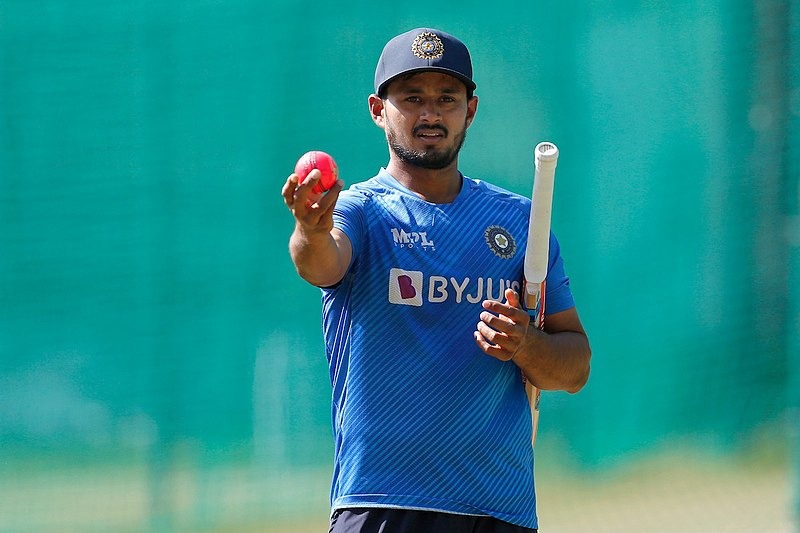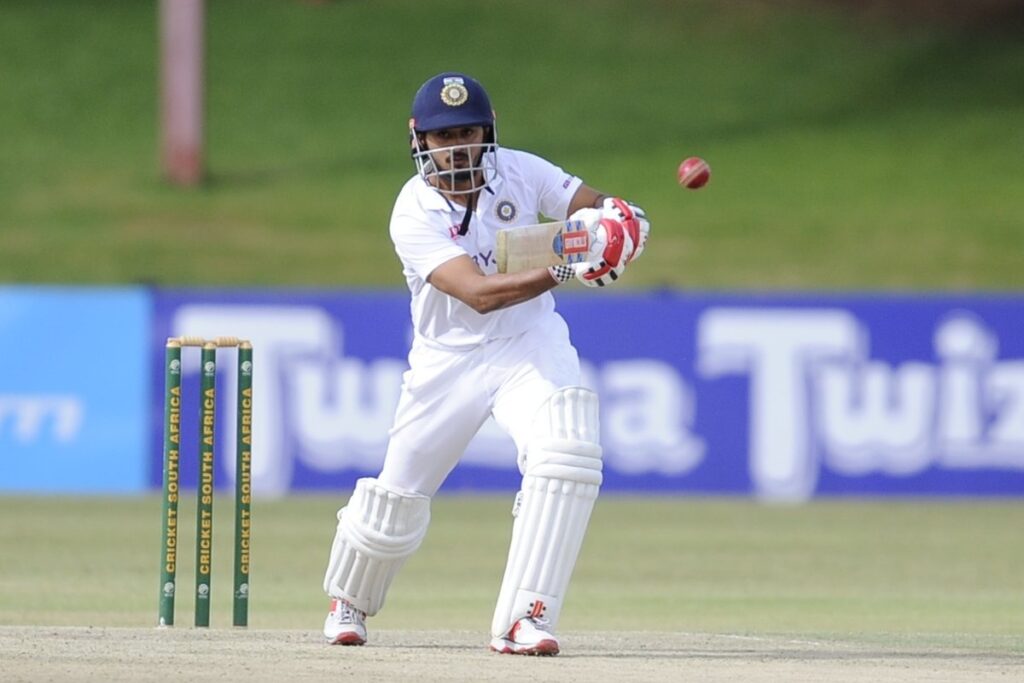Many years ago, Priyank Panchal’s childhood coach made a prophecy about how he would one day end up playing for India. That prediction almost came true in 2021-22. “One of my coaches, when I went to a coaching camp, said, ‘this boy will play for India’,” Panchal told RevSportz. “I remember those words, and I did end up being in the Indian squad (for the tour of South Africa). The name of my coach was Kiran Prambath.”
Although Panchal hasn’t yet played for India, he has been a prolific run-getter for Gujarat in first-class cricket, having amassed 7,901 runs. He has also consistently averaged over 50 since the start of the 2015-16 first-class season. But behind all those runs and big hundreds is the story of a cricketer who has had to undergo quite a few hardships.
At a young age, Panchal lost his father. As someone who was not from a financially well-off family, he had to navigate through a quagmire. During the difficult phase, his family members rallied around to help each other. Amid all the difficulties, they visualised fulfilling one goal.
“That happened (losing his father) when I was 14 or so,” said Panchal. “So, it was very difficult for me and my family, because it happened all of a sudden. But I was so lucky as my mother and sister helped me a lot during my early days of playing cricket. They always wanted me to focus on my cricket, so that I could perform better. Obviously, that (his father’s untimely death) was not in our hands, but those days were important for us – jo matlab buri cheez mein bhi aap acha seektha ho na [you can take the good even from the bad, right]?
“Financial difficulty was there, that was the main point. To purchase anything, you need money. We faced a lot of struggle. My mother worked really hard, she was into fashion designing, so that we could focus on our careers – my sister and I. Along with my mom, my sister also worked hard, so that I could focus on my career.”
Incidentally, it was his father’s dream that made Panchal take up a game that involved willow and leather. An anecdote from his childhood days doesn’t just tell us about his sheer enthusiasm for the game of cricket, but also how a certain bat turned out to be his lucky charm right through his age-group career. “I started because of my father, he wanted me to play cricket,” said Panchal. “During my childhood days, I only played cricket and not much. My father was also a cricketer. He didn’t play Ranji Trophy or anything, but he really loved cricket. I started playing at the age of eight or nine. Then at the age of 15, I got selected for the Under-15 state team.
“I kept on playing with a bat that my father bought for me. I played with it for four to five years or more. During my Under-15 days, I was scoring a lot of runs for my school and in state cricket. In school cricket, I scored 342 runs in one of the matches with the same bat.”
Despite having to get through some tricky phases, Panchal made his entry into the Gujarat side at the age of just 18. However, he could compile only two first-class tons over the first five seasons. Eventually, during the 2014-15 Ranji season, Panchal aggregated 537 runs at an average of 41.3.
Unfortunately for him, it wasn’t enough to get into the Duleep Trophy side. Panchal took that setback in his stride, and used it as a motivational tool. Training workshops became his second homes as he practiced in different ways in order to achieve his vision.
“During the 2014-15 season, I scored 500-odd runs and two hundreds, and I didn’t get a chance for Duleep Trophy,” he said. “I was so frustrated as to why I didn’t get a chance. That time, one thing that came to mind was that if I scored 1000 runs in a season, then no one would stop me. So, I took on that challenge, and after one season, ended up scoring 1300 runs (1449 in 2016-17). So the mental shift was that I had to score 1000 runs. So to score 1000 runs, what kind of things do I have to be prepared for? What kind of mental challenges? What kind of pressure do you have to take?
“So, I used to practice on a wicket – cement track. I kept using different balls. One of the ball-feeders with whom I was working, he had like five-six balls. And I didn’t know which ball he is going to bowl. One was a tennis ball, one was a very old seasoned ball, one was a new ball. I didn’t know which ball is coming. So, bounce variation, seam movement, swing variation… all those things I covered. As an opening batter, you must be very strong with your eyesight: which ball you have to leave, which ball you have to play. In order to focus more on watching the ball, and to decide which shot I should play or not, I worked on those things.”
This writer also had a chance to watch Panchal from close quarters during a Ranji Trophy game against Tamil Nadu in 2016. While witnessing Panchal’s long vigil at the crease, it felt as if he had improved his game through the off-side over a period of time. So, was it an aspect of the game that Panchal had worked on? “You can take any batter in the world, any bowler is going to bowl outside the off stump most of the time,” he said. “So I thought playing shots is not a bad option, as you have to also score runs. if you’re leaving the ball the whole day, you will end up scoring very few runs. So, cover-drive I improved, square-drive I improved, square-cut, back-foot punch… all those things, I improved. That really helped me.”
Panchal has composed some massive scores in domestic cricket – 314, 206, 257 – which in turn exemplify his reservoirs of patience. But his career isn’t just about massive scores in good batting conditions. He has also made timely contributions in challenging climes. A couple of such knocks came at Port of Spain against West Indies A in 2019: 58 and 68. In the first innings, India had found themselves in dire straits at 20 for 5 against the likes of Chemar Holder and Romario Shepherd. But Panchal steered India A to calmer waters. In the second innings, his knock laid the foundation for a memorable come-from-behind win.
“No one watches these 50 runs, 60 runs, but that was one of the best knocks I have played, on a difficult track,” said Panchal. “Everyone was there – Shubman [Gill] was there, [Hanuma] Vihari was there, Mayank [Agarwal] was there. I knew that if I scored a few runs there, then my team would definitely win. On that day, I was playing really well, I was comfortable on that wicket. I knew when to strike the ball, when not to. And I love playing fast bowlers. If the wicket offered seam movement (or there was) swing, I love to play that. It was an up-and-down wicket, it was spongy, some areas were dry, so some deliveries were shooting through. And one of the bowlers – Holder – was bowling really well. He was bowling bodyline, and some of the deliveries he was bowling on the front foot (fuller). So it was challenging, and I scored runs.”
If we rewind further back to 2016, Panchal had also accumulated a superlative ton on a grassy wicket against Railways in Lahli. During that time, scoring a century at Lahli was akin to passing the litmus test against fast bowling in India, as the decks at that venue used to offer considerable movement. “What happened was, during that time it was one of the toughest wickets to bat,” said Panchal. “Perhaps not much now but during that time, it was like that.
“We were playing Railways, and in the first innings, I got out (cheaply). In the second innings, there was a chance. I was thinking, ‘if I play 20 balls, then I am going to score runs’. So I counter-attacked, playing cricketing shots. They had a good attack – Anureet Singh and others. But I took it as a challenge, I knew that I was the only one (in the team) who could score runs, because you come to know who can play fast bowling well, who can play spinners well in the team. So, that moment was really satisfactory.”
One of Panchal’s notable qualities is his ability to find an erase button in his mind and forget the outcome of the previous ball. Even if that meant he had been beaten on the outside or inside edge, the previous delivery. So how does he go about constructing his innings? “The most important thing if you get beaten is not to tell yourself that you’re not playing well,” observed Panchal. “Sometimes, it also happens that the bowler is also bowling really well, and the wicket is also not that easy. But you have to think practically and also from a broader perspective.
“Many times, it also happens if you get through such a phase, you feel so strong that you think, ‘if I play these five or 10 overs on this kind of a difficult track, I can score easily.’ So it happened with me a lot of times, and it must have happened with so many other players. At the end of the day, what matters is scoring runs. If you’re batting on three figures at the end of the day, no one will talk about that 10-over phase.”
Batting, especially the longest format, isn’t just about the runs you score. But as a Test or first-class game can last for four to five days, it is also about how you switch off from cricket for a while after your innings gets over. Outside the world of cricket, Panchal is an avid reader, and he has varied interests. “Regardless of good days or bad days, I end up reading a book,” he said. “I want to stay neutral, whether I score 100 runs or zero. Because I want to stay neutral, I follow one strategy – just read a book for a while after you come back from the match.
“That freshens me up, and changes my perspective. Reading is something that I really love. When I started playing cricket, I was so curious about things apart from cricket. I started with self-help books, then I moved to autobiographies and biographies of cricketers – Sunil Gavaskar sir, VVS Laxman sir, Ricky Ponting sir. After reading cricketers’ autobiographies, I moved to artificial intelligence and machine learning… human psychology. I love to know about businesses, entrepreneurship and start-ups. So I was reading that also.”
Despite all the hurdles and obstacles, Panchal has been patiently pursuing the chariot of his dreams. He has also achieved most of his goals, but that elusive India Test cap is still missing from his cabinet. At 33, he isn’t exactly a young cricketer knocking on the doors of selection. For now, the selectors seem to be looking at younger batters like Yashasvi Jaiswal and Ruturaj Gaikwad to take over the top-order slots. But the dream still burns bright in Panchal’s eyes. Perhaps it would take one more stellar season with the bat for him to find a place in the India XI? Panchal, for one, hopes so. As would his childhood coach.
“Obviously you want to play for the country,” said Panchal. “If you were almost there, and if you don’t get a chance, it is difficult to handle. I keep on saying to myself, ‘one more good season and just prepare for the worst thing’. I mean it could be a turning track or solid seaming track, just prepare for that. Who knows? You might get a call tomorrow, and should be prepared. In the last few years, I have been following the same thing. If you look at my scores last season, I scored 587 runs. Unfortunately, I got injured, I suffered a fracture in the game against Madhya Pradesh. I was aiming big, but got injured.”
For one of Indian cricket’s domestic stalwarts, it’s the luck that has to change.






